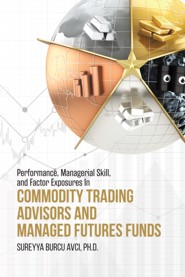LibraryBusinessBusiness Management & Administration
Performance, Managerial Skill, and Factor Exposures in Commodity Trading Advisors and Managed Futures Funds
| Institution: | Ozyegin University |
|---|---|
| Advisor(s): | Mustafa Onur Caglayan |
| Degree: | Doctor of Philosophy |
| Year: | 2016 |
| Volume: | 154 pages |
| ISBN-10: | 1612334733 |
| ISBN-13: | 9781612334738 |
Abstract
Understanding risk is important. Prior to 2008, as the yields on safe assets hit rock bottom, investors began to focus on an alphabet soup of more complex instruments. These complex securities were rated AAA and appeared as safe as U.S. Treasuries, but with much higher yields. The 2008 financial crisis revealed, however, that higher yields on these instruments came with higher risk, albeit too late for these investors. This study seeks to understand the risk--return tradeoff, managerial skill, and factor exposures on the risk-return tradeoff in two financial instruments that have been limitedly investigated: commodity trading advisors (CTAs) and managed futures funds (MFFs).
This study begins by documenting the differences between CTAs/MFFs and hedge funds and mutual funds, starting with the legal and operational differences. Next, it conducts a performance analysis, which indicates that CTAs and MFFs, as standalone investment vehicles, provide returns that are higher than the average market returns in bear markets, while carrying lower risk. The strong standing of CTAs and MFFs in bear markets earn them their reputation as "downside risk protectors." CTAs and MFFs are profitable individual assets but adding these funds to classical asset portfolios enhances portfolio performance significantly. This feature makes them strong hedging assets. As expected, their performance is below that of standard assets in up markets.
Chapter 4 finds that the superior performance of CTAs and MFFs can be explained by managerial skill. Positive and significant Jensen alphas are evidence of good performance; moreover, the persistence of the Jensen alphas is supported by both parametric and non-parametric tests. Incentive fees and fund age are found to be positively related to managerial skill, while (somewhat surprisingly) management fees are found to be negatively related to it.
Chapter 5 finds that many financial and macroeconomic factors are statistically unrelated to CTA and MFF performance. However, the value premium (HML) factor and industrial production growth (IPG) are correlated with their performance. HML has a relation effect on one-month-ahead fund returns, whereas IPG has a negative association with them. Nonparametric tests support these results marginally. Overall, these findings suggest that both CTAs and MFFs use well-known and well-established predictors of expected returns to generate their alphas.

